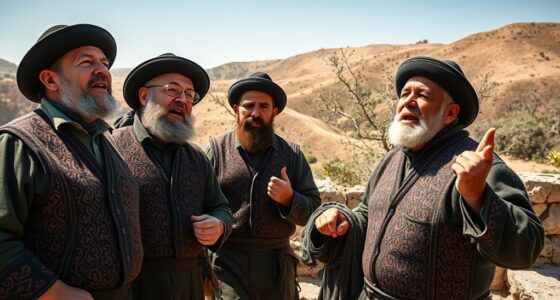Vite ad alberello is a centuries-old vine training method unique to Pantelleria that involves shaping vines close to the ground along a simple, low trellis. This tradition reflects the island’s cultural heritage, helping protect grapes from strong winds and extreme heat. It also promotes sustainability by reducing water use and supporting natural growth. If you want to discover how this ancient practice enhances the island’s resilient winemaking, there’s much more to explore.
Key Takeaways
- Vite ad alberello involves training vines close to the ground along simple trellises, preserving Pantelleria’s centuries-old winemaking heritage.
- This traditional method protects grapes from coastal winds and extreme heat, ensuring high-quality harvests in harsh climates.
- The low-lying vines help conserve soil moisture and reduce water loss, supporting sustainable and eco-friendly cultivation.
- It embodies a cultural practice that harmonizes with the environment, fostering resilience against climate challenges.
- The technique maintains ecological balance and safeguards Pantelleria’s unique winemaking identity for future generations.

Vite ad Alberello is a traditional Italian grape-growing method that involves training vines to grow close to the ground along a simple, low-lying trellis. This technique isn’t just about tradition; it’s a proof of centuries of craftsmanship that harmonize with the environment. By adopting this method, you’re engaging in a form of traditional craftsmanship that has been passed down through generations on Pantelleria. It’s a way of working with the land, respecting its natural rhythms, and guaranteeing the vines thrive in challenging conditions. The low-lying structure helps protect the grapes from strong coastal winds and harsh sun, which are common in this Mediterranean landscape. When you use this approach, you’re not only preserving a cultural heritage but also creating a resilient system tailored to the island’s unique climate.
Climate adaptation is at the core of the Vite ad Alberello technique. Pantelleria’s climate presents specific challenges—intense heat, drought, and unpredictable weather patterns—that demand smart solutions. Growing vines close to the ground offers natural insulation, helping maintain soil moisture and shielding roots from extreme temperatures. The dense canopy created by this vine training method reduces water loss through evaporation and provides shade, which is essential in a semi-arid environment. This adaptation isn’t accidental; it’s a deliberate choice rooted in centuries of experience. By training the vines low, you harness nature’s own mechanisms for survival, reducing the need for excessive irrigation or artificial interventions. This resilience guarantees that, even in tough conditions, the grapes can reach maturity and produce high-quality wine.
This method also reflects a sustainable approach to agriculture. You minimize the use of chemical inputs, relying instead on traditional knowledge and natural defenses. In doing so, you’re supporting biodiversity and maintaining the health of the soil. The low-growing vines can better withstand climatic stressors, making the vineyard more sustainable over time. As climate change threatens vineyards worldwide, Vite ad Alberello stands out as an example of how traditional practices can serve as effective climate adaptation strategies. By working with the land’s natural inclinations, you preserve not only the cultural identity of Pantelleria’s winemaking but also guarantee its future resilience. This craftsmanship and climate-conscious approach make Vite ad Alberello an essential part of the island’s heritage, blending history, environment, and sustainability into a single, enduring tradition.
Frequently Asked Questions
How Does Vite Ad Alberello Impact Grape Quality?
Vite ad alberello enhances grape quality by promoting a traditional canopy that maximizes sun exposure and airflow, reducing disease risks. This technique also helps preserve the soil by minimizing the need for heavy machinery and chemical interventions, maintaining soil health. You’ll notice the grapes develop concentrated flavors and balanced acidity, resulting in wines that truly reflect Pantelleria’s unique terroir. This method supports sustainable practices while improving overall vineyard robustness.
Is Vite Ad Alberello Suitable for Other Grape Varieties?
You might consider vite ad alberello for other grape varieties, as its benefits include enhanced climate adaptability, improved air circulation, and better sun exposure. While traditionally used for local varieties, this technique can be adapted for alternative grape varieties, especially in challenging climates. However, you should evaluate each variety’s growth habits and climate requirements to determine if vite ad alberello suits their specific needs and guarantees ideal quality.
What Are the Main Challenges of Maintaining This Tradition?
You’ll find maintaining the vite ad alberello tradition challenging mainly due to climatic conditions and labor intensity. The hot, windy climate demands constant attention to prevent vine damage, while the labor-intensive manual training and pruning require significant time and effort. This tradition’s delicate nature makes it hard to adapt on a larger scale or in different regions, but its unique character keeps it essential for preserving Pantelleria’s heritage.
How Does the Training Method Influence Wine Flavor?
Your vine training method greatly influences flavor development by shaping canopy management, which controls sunlight exposure and air circulation. This results in grapes developing concentrated sugars and nuanced aromatics, enhancing the wine’s complexity. The traditional Alberello style promotes ideal ripening and mineral notes, giving your wine a distinct character. By carefully managing the canopy, you guarantee the grapes achieve the desired flavor profile, reflecting Pantelleria’s unique terroir.
Can Vite Ad Alberello Be Adapted to Modern Vineyards?
Think of vite ad alberello as a living bridge connecting tradition and innovation. You can adapt this method to modern vineyards by focusing on historical preservation and climate adaptation. This technique’s resilience allows you to maintain cultural heritage while adjusting for changing conditions, making it a sustainable choice. Embracing vite ad alberello in contemporary settings preserves history and supports your vineyard’s future, blending old-world charm with modern resilience.
Conclusion
So, next time you sip that glass of Pantelleria’s finest, remember you’re enjoying a miracle of tradition. While other vineyards race toward automation and uniformity, these brave vines cling to their ancient, quirky ad alberello method—literally. Cheers to defying modern trends and proving that sometimes, the best things in life are still hand-tied, sun-kissed, and rooted in a tradition that’s as charmingly stubborn as you are. Cheers to the vine’s glorious rebellion.









